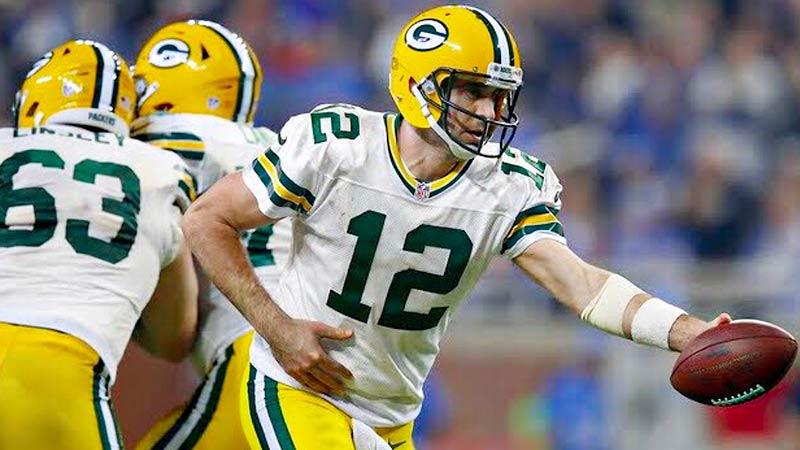In the realm of American football, strategic finesse often takes the form of well-executed plays that blur the line between reality and deception.
Among these, the play action stands as a masterstroke of offensive orchestration, leaving defenders befuddled and creating prime opportunities for explosive passing gains.
In this exploration of the tactical marvel known as football play action, we delve into its intricacies, its role in modern gameplay, and how both offensive and defensive units harness its potential to shape the course of a game. Stay focused.
What Is Football Play Action?
Football play action, often referred to as a play-action pass, is a strategic offensive maneuver in American football. It involves a quarterback faking a handoff to a running back or pretending to execute a running play, before quickly transitioning into a passing play.
This deceptive tactic aims to confuse the defense by causing them to react as if a run play is imminent, drawing defenders closer to the line of scrimmage.
This creates windows of opportunity for the quarterback to target receivers downfield, as defenders may momentarily be out of position or caught off-guard.
Play action capitalizes on the defense’s instinct to defend against the run, allowing the offense to exploit the resulting openings for successful passing plays and potentially gain significant yardage.
Elements of Successful Play Action
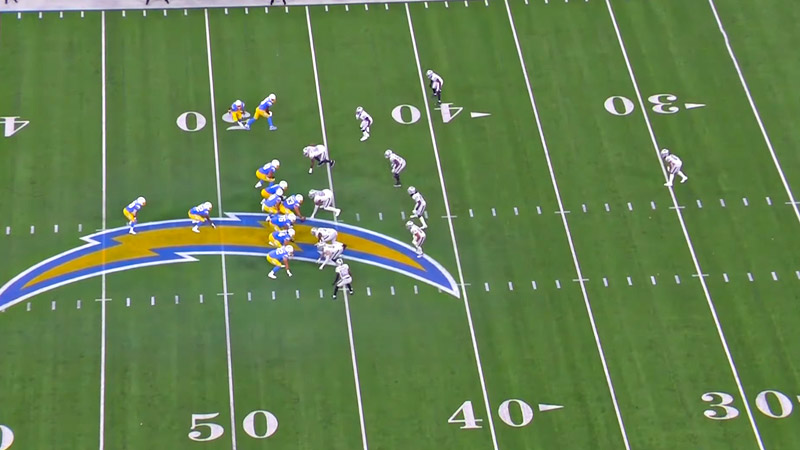
Successful play action in football involves several key elements:
Believable Run Threat
The effectiveness of play-action relies on a credible running game. The defense must genuinely believe that a running play is possible, causing defenders to commit to stopping the run.
Synchronized Timing
The quarterback’s execution must be precise. The fake handoff and subsequent pass should occur in a fluid motion to capitalize on the moment when defenders are most vulnerable due to their commitment to stopping the run.
Offensive Line Performance
The offensive line’s blocking should mimic that of a real running play initially, further convincing the defense of the run’s possibility. The line must protect the quarterback during the transition from fake run to pass.
Receiver Separation
Wide receivers and tight ends should create separation from defenders quickly after the fake. This ensures they are open targets for the quarterback’s pass downfield.
Quarterback’s Arm Mechanics
The quarterback’s throwing motion during the fake should mirror their actual throwing motion. This maintains consistency and prevents defenders from recognizing a deviation that might signal a pass.
Defensive Reaction
The success of play action depends on causing the defense to react to the fake run. If defenders bite on the fake and move toward the line of scrimmage, passing lanes open up for the quarterback.
Variation and Deception
Mixing up play-action plays with actual running plays, and occasionally using play-action on passing downs, enhances the element of surprise and keeps the defense guessing.
Downfield Options
The offense should have multiple receiving options downfield. This gives the quarterback flexibility in choosing targets based on how the defense reacts to the play action.
Effective Play Design
Coaches and coordinators design plays that cater to the team’s strengths, utilizing play action to exploit specific defensive weaknesses.
Practice and Repetition
Like any football play, the successful execution of play action requires practice and repetition. The entire offense needs to be well-coordinated and accustomed to the timing and mechanics involved.
Timing and Execution in Play Action
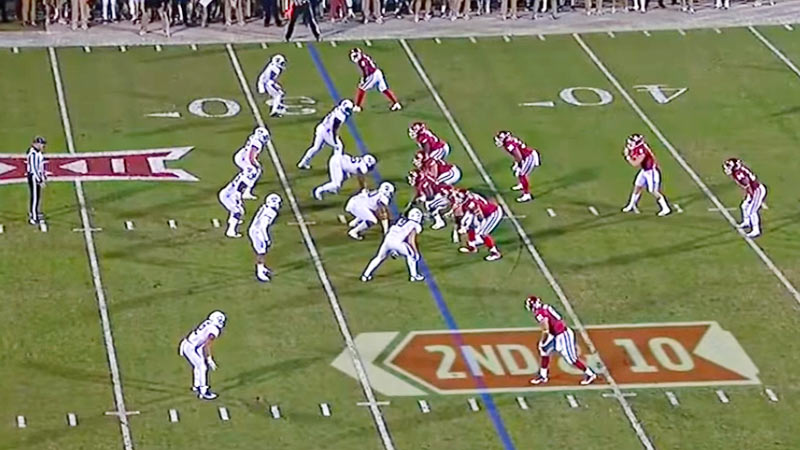
Timing and execution are critical aspects of successful play action in football:
1. Timing
The timing of play action is essential to deceive the defense effectively. The quarterback’s actions should mirror those of a legitimate running play until the last possible moment. The key moments in play action timing include:
Snap and Handoff Simulations
The quarterback’s initial movements should replicate a real handoff to the running back, drawing defenders’ attention to the backfield action.
Transition
The transition from the fake handoff to the pass should occur as the defense commits to stopping the run. This is usually a split-second decision by the quarterback, made based on the positioning of defenders.
Release
The quarterback should release the ball quickly after the transition to take advantage of the momentary confusion among defenders.
2. Execution
Executing play action effectively involves several components:
Footwork
The quarterback’s footwork should mimic that of a real handoff or run play. This helps sell the fake to both defenders and the audience.
Ball Handling
The quarterback’s ball-handling skills are crucial in making the fake look convincing. The precise execution of the fake handoff adds realism to the play.
Reads
The quarterback needs to read the defense during the fake and transition. This involves recognizing which defenders are reacting to the run and identifying open passing lanes.
Mechanics
The quarterback’s throwing mechanics during play action should be consistent with those of a regular pass. This prevents defenders from detecting any differences in the quarterback’s motion.
Offensive Line
The offensive line plays a pivotal role in selling the run fake. Their blocking posture and movement must resemble that of a run play initially, fooling the defense.
Receiver Routes
Receivers must execute their routes precisely and create separation from defenders after the fake. This gives the quarterback viable targets downfield.
Ball Delivery
The quarterback’s pass should be accurate and well-timed to capitalize on the openings created by the fake. An off-target throw could waste the opportunity created.
Post-Snap Reads
If the defense doesn’t fully bite on the fake, the quarterback should be prepared to make quick decisions and progress through alternative reads.
Incorporating impeccable timing and execution into play action plays demands coordination among the entire offensive unit.
Types of Play Action Plays
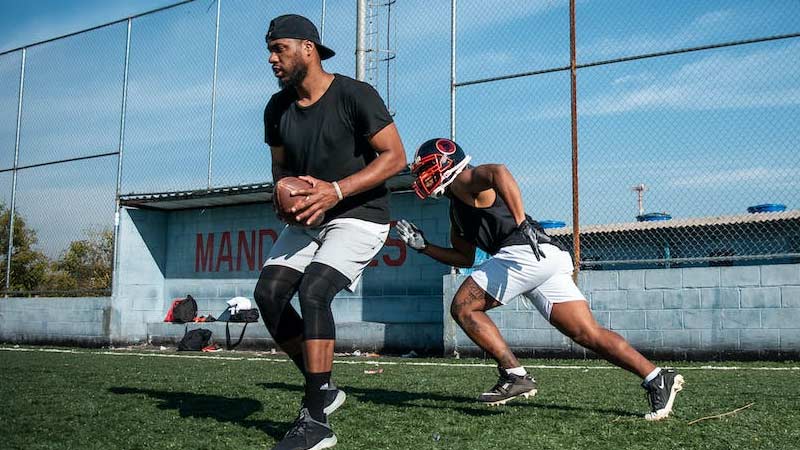
There are several types of play action plays used in football to exploit defensive vulnerabilities and create successful passing opportunities:
Standard Play Action
The quarterback fakes a handoff to the running back, simulating a running play before transitioning into a pass. This is the most common form of play action and aims to capitalize on defenders who bite on the fake.
Bootleg Play Action
In this variation, the quarterback rolls out to one side of the field after faking the handoff. This play-action type is designed to take advantage of the defense flowing in the direction of the fake, allowing the quarterback to have a clear passing lane while on the move.
Naked Play Action
Similar to the bootleg, but with less offensive line movement. The offensive line doesn’t initially move in the direction of the run fake, making it look more like a passing play from the outset.
Waggle Play Action
This is an extreme form of bootleg where the offensive line moves strongly in one direction, often away from the actual play, creating an unobstructed path for the quarterback to roll out and pass.
Play Action Screen
The quarterback fakes a handoff, drawing defenders toward the line of scrimmage, and then quickly tosses the ball to a screen receiver positioned behind the offensive line. The goal is to exploit the aggressiveness of the defense and create space for the screen receiver to gain yardage.
Deep Play Action
This play involves a longer-developing pass downfield. The quarterback takes a deeper drop to give receivers more time to get open, capitalizing on the defense’s focus on the run fake.
Play Action Draw
In this variation, the quarterback fakes a pass and then hands the ball off to a running back for an actual rushing attempt. This play aims to catch defenders off-guard, expecting a pass.
Play Action Counter
A play-action counter involves faking a running play in one direction and then having the quarterback pivot and pass to a receiver or tight end moving in the opposite direction. It aims to exploit defenders overcommitting to the initial fake.
Play Action Slant
The quarterback fakes a handoff and then quickly throws a slant route to a receiver. This play aims to catch defenders off-balance and take advantage of a quickly developing passing route.
Play Action Post
The quarterback fakes a handoff and launches a deep pass to a receiver running a post route downfield. This play capitalizes on the defense’s focus on the run fake to create space for the receiver to get open.
These different types of play-action play add variety to an offense’s strategy, keeping the defense guessing and adjusting to different scenarios.
When to Use Play Action in American Football?
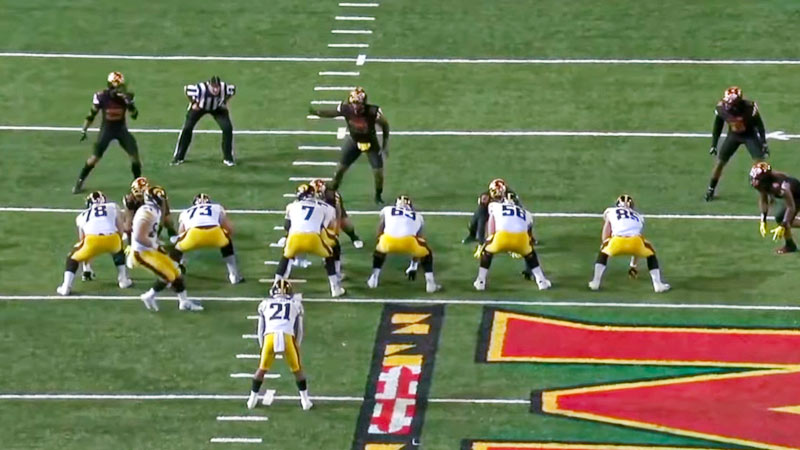
Play action in American football is most effective when used strategically to exploit defensive tendencies and create favorable passing situations. Here are some situations when play action can be particularly advantageous:
Early Downs
Play action is often used on first or second downs, especially if the offense has gained consistent yardage on running plays. Defenses tend to be more focused on stopping the run early in the series, providing an opportunity to catch them off-guard with a pass.
Short Yardage
When the offense needs only a few yards for a first down or a touchdown near the goal line, play action can be effective. Defenses often commit extra resources to stop the run in these situations, leaving openings for pass plays.
Successful Running Game
If the running game has been effective earlier in the game, play action can capitalize on the defense’s increased focus on stopping the run. This can lead to open passing lanes and opportunities for big gains.
Defensive Aggressiveness
When facing an aggressive pass rush or blitz-heavy defense, play action can slow down defenders by making them hesitate to rush the quarterback, providing the quarterback with more time to throw.
Downfield Passes
Play action is commonly used on plays designed for longer passes downfield. The fake run can freeze or draw in the defensive backs, giving receivers time to get open deep down the field.
Setting Up Screen Passes
Play action can be used to set up screen passes, as the defense’s aggressive pursuit of the quarterback can create open space for the screen receiver to exploit.
Exploiting Overcommitment
If the defense consistently overcommits to stopping the run, play action can take advantage of their vulnerability by creating space for receivers in areas vacated by defenders.
Change of Pace
After a series of running plays, using play-action can catch the defense off-guard, as they may not expect a passing play following several consecutive runs.
Misdirection Plays
Play action can complement misdirection plays, where the offensive players’ movements and actions deceive the defense. This makes it difficult for defenders to predict the direction of the play.
Critical Game Situations
Play action can be effective in crucial game situations, such as two-minute drills, red-zone situations, and third-down conversions. Its deceptive nature can help the offense gain critical yardage when needed.
Defending Against Play Action
Defending against play action in American football requires a mix of disciplined execution, smart positioning, and reading the offensive cues. Here are some strategies for effectively defending against play action:
Stay Disciplined
Defenders must maintain their assignments and responsibilities, even in the face of play-action. Avoid being drawn in by the fake run, as this can leave gaps in coverage.
Recognize Key Indicators
Defensive players need to read key indicators such as the offensive line’s movements and the quarterback’s body language. Sudden pass protection stances from offensive linemen and the quarterback’s quick transition to a passing stance are signs of play action.
Communication
Effective communication among defensive players is crucial. Linebackers and defensive backs must communicate to ensure that everyone is aware of their assignments and any potential shifts in coverage.
Read the Offensive Backfield
Safeties and linebackers should pay attention to the running back’s actions. If the running back’s movements appear inconsistent with a genuine run play, it might be an indicator of play action.
Maintain Coverage Depth
Defensive backs must maintain their coverage depth and resist the temptation to come forward to defend against the run. This prevents receivers from getting behind the defense for deep passes.
Read the Offensive Line
Defensive linemen should be attentive to their blocks and the actions of the offensive linemen. If the linemen remain engaged with pass protection rather than aggressively engaging in run blocking, it’s likely a pass play.
Defend Tight Ends and Receivers
Linebackers and defensive backs need to cover tight ends and receivers effectively, even if the initial movement suggests a running play. Staying disciplined and not biting on the fake is crucial.
Pressure the Quarterback
Applying pressure to the quarterback can disrupt the timing of play-action plays. If the quarterback feels rushed, it reduces the effectiveness of the play’s transition from fake to pass.
Film Study
Defensive players can identify tendencies in the offense’s play-action game through film study. This helps them anticipate play-action plays and react accordingly.
Practice Against Play Action
During practice, defensive players should simulate defending against play-action plays. This helps improve their recognition skills and reinforces the importance of staying disciplined.
FAQs
What is Football Play Action?
Football play action, also known as a play-action pass, involves the quarterback’s ingenious art of simulating a running play before transitioning swiftly into a passing play.
This deceptive maneuver exploits defenders’ commitment to stopping a potential run, creating windows for precise downfield passes.
When is Play Action Most Effective?
Play action finds its prime moments on early downs, after successful running plays, and when facing aggressive defenses. It’s a potent tool for exploiting defensive aggressiveness, setting up long passes, and changing the tempo of the game.
How is Timing Crucial in Play Action?
Timing is the heartbeat of play action. The quarterback’s execution hinges on the perfect synchronization of the fake handoff, transition to pass, and the release of the ball. Precise timing capitalizes on defenders’ commitment to stopping the run and maximizes passing opportunities.
What Are the Types of Play Action Plays?
Play action comes in various flavors, each tailored to exploit specific defensive scenarios. These include standard play action, bootleg, naked, deep play action, and more. Each type adds a unique layer of complexity to an offense’s strategy.
How Do Defenses Counter Play Action?
Defending against play action requires disciplined execution, keen observation, and communication. Recognizing key indicators like offensive line movement and maintaining coverage depth is crucial in neutralizing the effectiveness of play-action plays.
Wrapping Up
Football play action is a symphony of strategy and execution that can sway the tide of a game in mere moments.
As we’ve unveiled its secrets, it becomes evident that play action isn’t merely a feigned motion; it’s a calculated maneuver that encapsulates the unpredictable beauty of the sport.
From its well-timed transitions to its creative adaptations, play action enriches the football narrative and ensures that each snap is a canvas for strategic brilliance. Thank you for your time.

